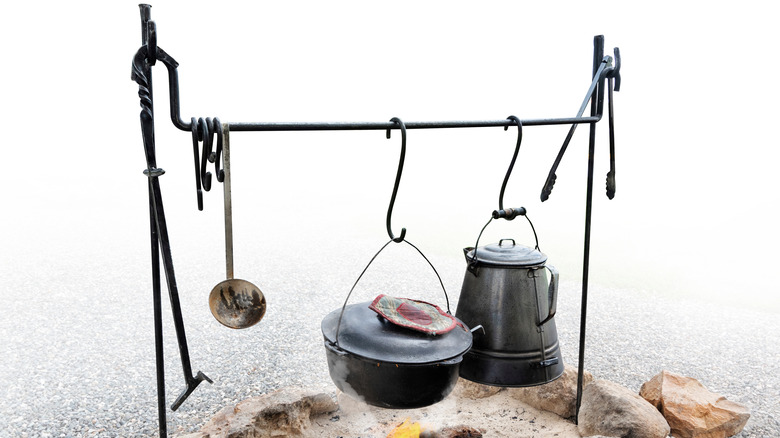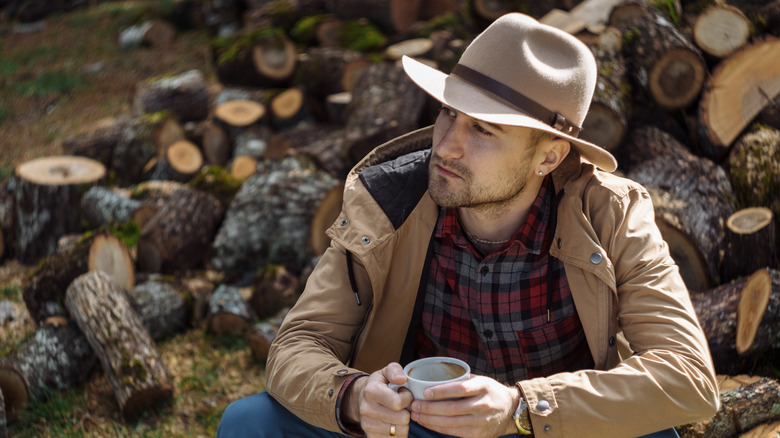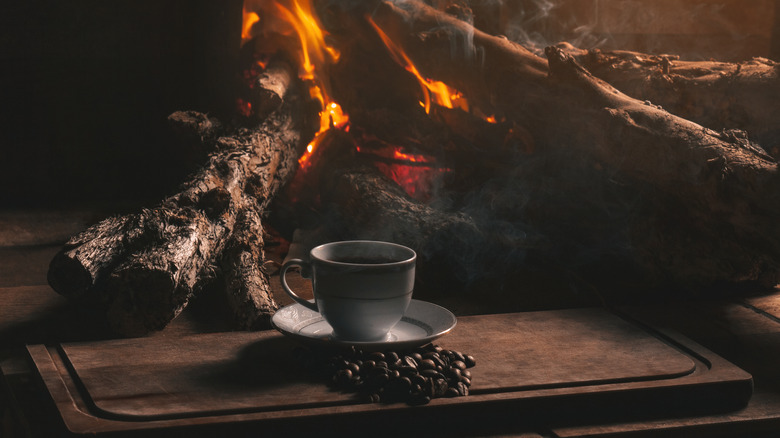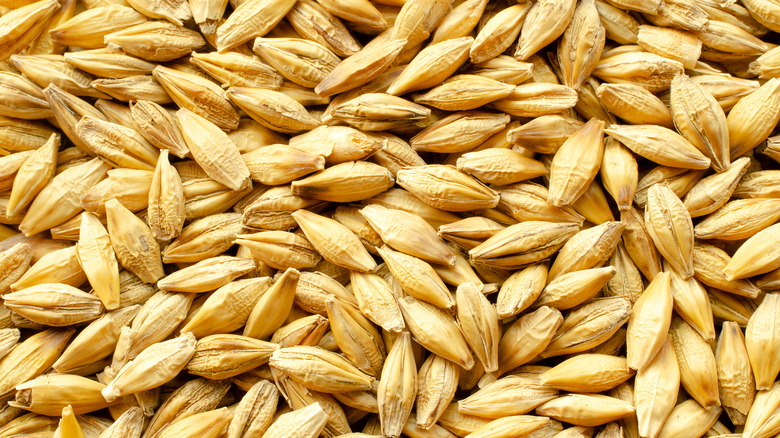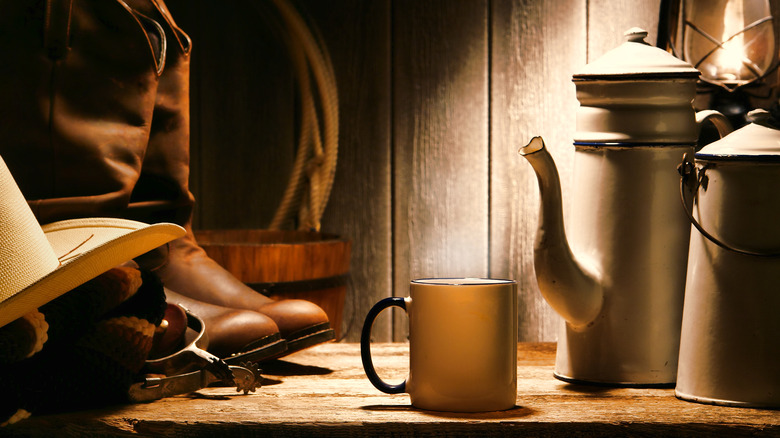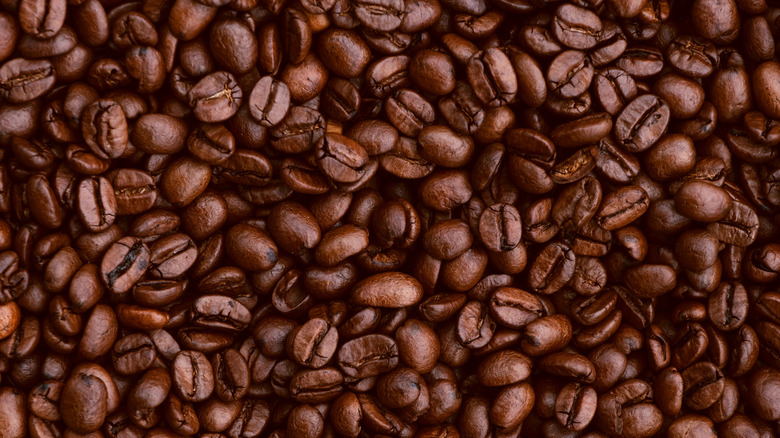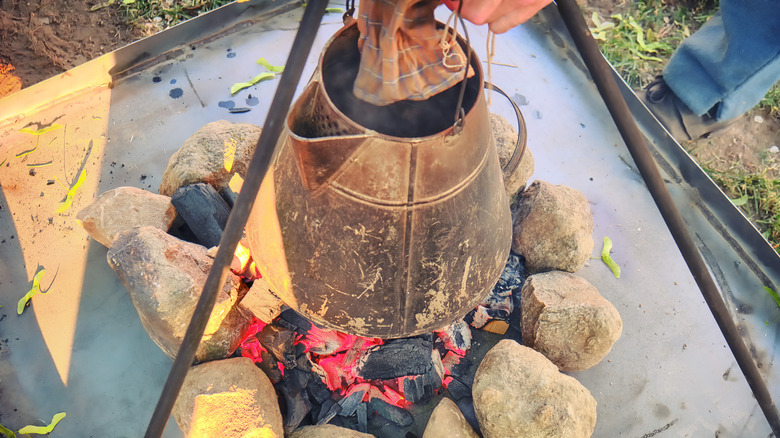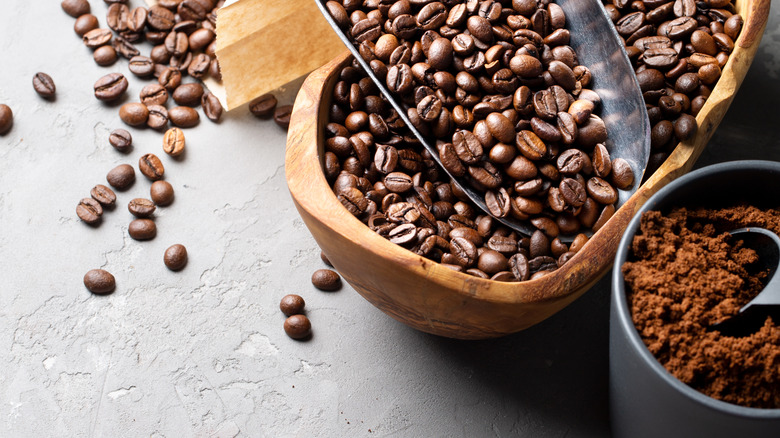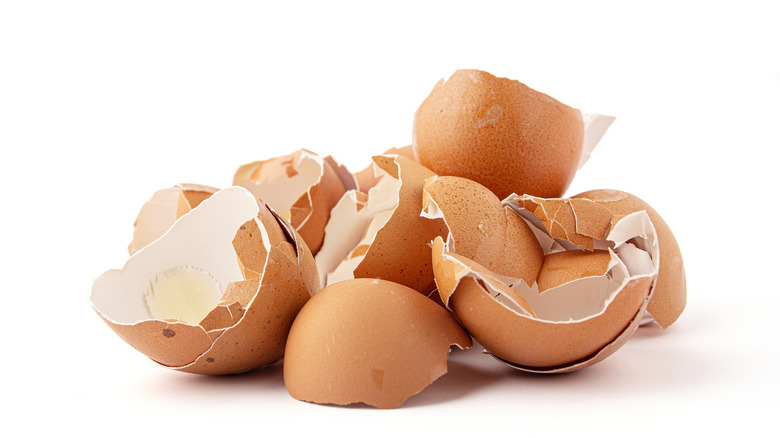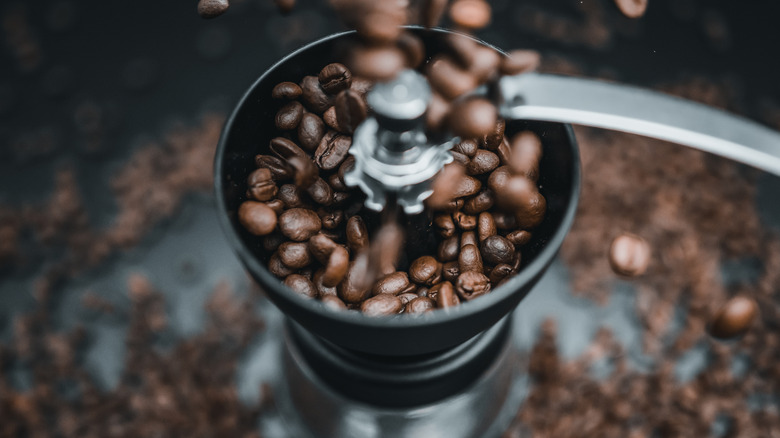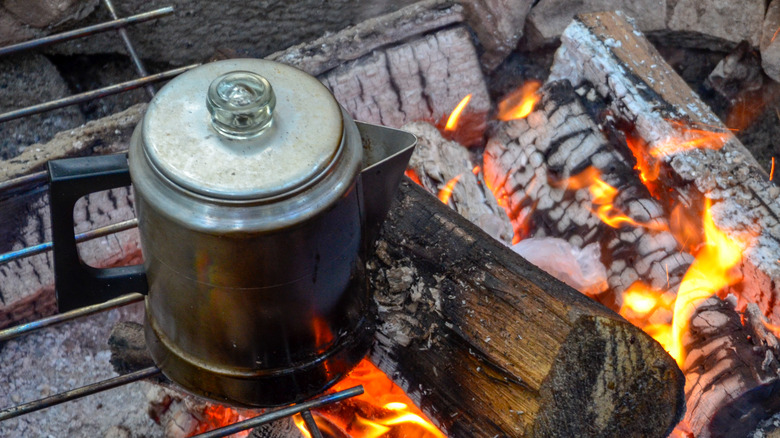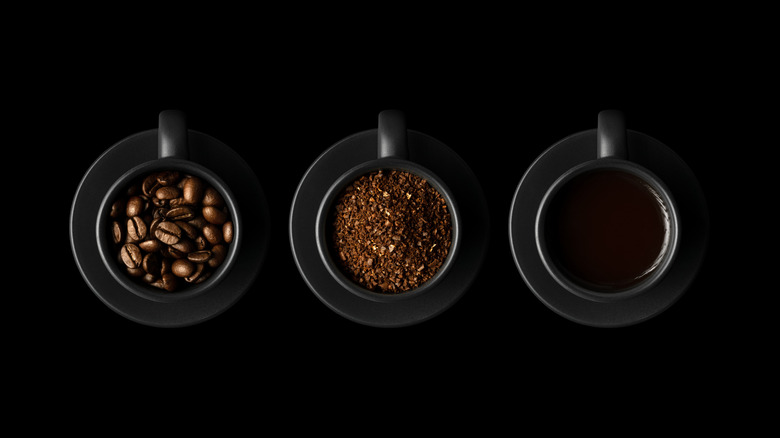The Untold Truth Of Cowboy Coffee
Depending on who you ask, cowboy coffee — a simple, rustic preparation of ground coffee and water boiled or steeped together in a pot or kettle — can be either the best or worst cup of coffee you'll ever experience. Made with care, cowboy cook Kent Rollins argues, cowboy coffee "is probably the smoothest coffee in the world." Still, cowboy coffee has also earned a reputation for being bitter and thick enough to hold up a spoon, suggesting many cooks fail to give their cowboy coffee the level of attention that Rollins recommends.
And given the history of the drink, it's easy to see why: Originally devised by chuckwagon cooks to keep teams of cowboys energized and hydrated during their long days (and sometimes nights) of hard physical labor, cowboy coffee requires no special equipment apart from what a cook on the open range would already have on hand — a pot or kettle, an open fire, and perhaps a long spoon, according to True West. And busy cooks charged with keeping dozens of hungry, tired men fed likely didn't have the time or energy for anything more than ensuring their coffee was hot, caffeinated, and plentiful. But while the simplicity of cowboy coffee can be its pitfall, it's also part of the drink's appeal, making it a popular choice with backpackers, campers, and those looking to enjoy a good cup of coffee without expensive machines or gadgets.
For early cowboys, the stronger the coffee, the better
Historically, cowboy coffee was not a treat, but essential fuel. As noted by True West, during cattle drives, cowboy coffee was not only served with every meal, but was often available between meals and even late at night — cowboys charged with monitoring their herds overnight would drink coffee before leaving the campfire for the open plain, and have more upon returning at the end of their shift. And True West notes that writings from the time confirm the fondness for coffee among not only cowboys, but others traversing the then-untamed west. As one pioneer, Julia Brier, wrote, "Our coffee was a wonderful help and had that given out, I know we should have died."
Because coffee provided the energy boost needed to endure long days of strenuous work, cowboys liked their coffee strong and black and had little patience for weaker stuff. The cooks who fed them were happy to oblige, even if this meant prioritizing density over flavor quality. Per True West, a common hack for getting the most out of every bit of coffee was to leave spent grounds in the pot and just put fresh ones on top of them when making a fresh batch. This not only saved cleaning time but ensured every grain gave its all.
Early recipes for cowboy coffee focused on strength, not taste
Part of the reason cowboy coffee sometimes gets a bad rap is that the techniques for making it seem just plain wrong by modern coffee aficionado standards. For instance, bringing the coffee to a hard boil, as many recipes require, is now considered a huge, flavor-destroying no-no by serious baristas. (On the other hand, some cowboy coffee experts insist that boiling, in fact, reduces acid levels and makes the coffee smoother.) And the idea of cooking coffee and water together with no filter and pouring the results straight into your cup brings to mind a mouthful of spent grounds, a prospect that makes even casual coffee drinkers cringe.
It doesn't help either that early ranch cooks charged with making coffee for their crews were more concerned about quantity and strength than flavor. As True West notes, one ranch cook reported going through 175 pounds of coffee beans a month. And for some cooks, an easy way to get their coffee to a suitable intensity was to boil, boil, then boil some more. An old recipe for cowboy coffee recorded in the 1945 book, "Western Words: A Dictionary of the Range, Cow Camp, and Trail," (per Sprudge) gives a set of instructions: "Take two pounds of Arbuckle's coffee, put in enough water to wet it down, boil it for two hours, then throw in a hoss shoe. If the hoss shoe sinks, she ain't ready."
Some early cowboys had to settle for coffee substitutes
Coffee's place of honor at the American breakfast table — and at virtually every traditional cowboy meal – has its roots in the American Revolution: American colonists, angered by high British taxes on tea, rejected the beverage as a matter of principle and turned to coffee instead. And even after fences had been mended between Britain and the U.S., Americans' love of coffee continued unabated, especially on the western frontier, where cowboys and travelers alike craved the morale-boosting energy it offered.
There was just one problem, however: Coffee was expensive (it was all imported by ship from the Caribbean and South America), and it was often hard to obtain in far-flung parts of the American West, according to True West. This meant some cowboys, especially in the years before the Civil War, had to settle for cowboy "coffee" made from ingredients other than coffee, such as corn, rye, okra seeds, or bran. It may not have delivered much of a buzz, but a hot drink is still welcome on a cold morning.
Here are the coffee brands to use for a historically accurate flavor
If you're trying to imagine the historic smell and taste of real-deal cowboy coffee, you may imagine an aroma of wood smoke from the fire over which the coffee was cooked, or perhaps a faint whiff of the cattle and horses grazing off in the distance. But what about the coffee? What kind of modern coffee could you use to recreate the flavor that old-time cowboys enjoyed? Obviously, that vanilla- or hazelnut-flavored blend in your freezer isn't going to cut it.
We do know that if you drank cowboy coffee in the first part of the 19th century, there was a good chance it tasted burnt. This is because coffee was mostly sold in the form of green beans, which cooks had to roast themselves before grinding and brewing. But roasting beans at home — or over a campfire on the open range — was tricky, and beans could go from toasty to burnt all too easily, according to Pittsburgh Magazine. Luckily for coffee lovers, two entrepreneurs — James Folger in California and John Arbuckle in Texas — independently recognized the demand for pre-roasted coffee beans and launched successful businesses preparing and selling them. Today, Folgers continues to be a household name, and Arbuckles, which became the coffee of choice at many cowboy camps, is likewise still on the market, if you want to recreate the traditional cowboy coffee experience.
Cowboy coffee was always made with freshly ground beans
Cowboy coffee may have a reputation in certain circles as sludgy and overcooked but unlike that pot sitting over a burner all day at your office, cowboy coffee historically had one huge advantage: It was always made from freshly ground (and in the early part of the 19th century, freshly roasted) beans, according to I Need Coffee. This means a well-made cup of just-brewed cowboy coffee was probably far fresher and tastier than anything you can get at your local coffee house now.
The use of whole beans in traditional cowboy coffee wasn't due to higher culinary standards, but to the simple fact that pre-ground commercial coffee wasn't yet available in the 19th century. And even the appearance of commercially roasted coffee beans (introduced by competing manufacturers Folgers and Arbuckles in the 1850s and 1860s) was considered a revelation to time-pressed coffee lovers accustomed to roasting their own beans. And while it's unlikely 19th-century cowboys thought to complain about having to grind their own beans, Arbuckles unknowingly offered an incentive to sweeten the task. Always striving to engage their customers, Arbuckles included a peppermint stick with each bag of coffee, and as History Net reports, all a chuck wagon cook had to do was yell "Who wants the candy?" to recruit an eager volunteer to grind the day's beans.
Techniques for making cowboy coffee vary
Traditionally, the appeal of cowboy coffee was its simplicity: All a cook had to do was heat up some water, add some coffee, and wait. But the devil's in the details, and on the open range, busy cooks likely had neither the time nor the equipment to monitor exact temperatures or coffee-to-water proportions, so the results could be variable, according to Sprudge. But over time, through trial and error, cooks devised an assortment of techniques and hacks for making cowboy coffee, ranging from adding a pinch of salt (to cut the coffee's acidity) to stuffing the coffee grounds into a sock before boiling. And cooks don't all agree on which tricks work: For instance, opinions differ as to whether it's better to add the coffee before bringing the water to a boil or afterward, according to Sprudge.
Modern cooks making cowboy coffee in smaller quantities (cups, rather than gallons) and in more controlled environments have further refined techniques for making cowboy coffee while preserving the original spirit of simplicity. The Roasterie, for example, recommends waiting for the water temperature to drop to 200 degrees before adding the coffee and using a precise 2 tablespoons of coffee for every 8 ounces of water. Furthermore, The Roasterie calls for steeping the coffee off direct heat rather than actively simmering or boiling it.
Here are some tricks for keeping grounds out of your cup
While working cowboys were historically accustomed to gritty, rustic lifestyles, it's unlikely any of them welcomed a mouthful of spent grounds with their coffee. But since cowboy coffee is typically made without any filter separating the coffee and water, the risk of getting grounds in one's coffee was an inherent risk. To address this, cooks developed a number of tricks for settling the grounds after brewing to keep them safely out of the way.
One common technique is to add cold water once the coffee has been brewed. Cowboy cook Kent Rollins, who cooks his coffee in a kettle with a long spout, pours a cup of cold water down the spout to wash down any grounds that may have risen through the spout as the coffee boiled. (He also recommends wiping the inside rim of your pot with a wet paper towel if any grounds appear there.) A variation of this technique recommended by Driftaway Coffee is to sprinkle a small amount of cold water directly onto the grounds after brewing to settle them before pouring. And some enterprising cooks avoid the problem altogether by boiling their coffee in an old sock, a technique Kent Rollins scorns, per Sprudge. "Who wore that sock before you put it in?" he asked.
Adding eggshells helps cut the coffee's acidity
Eggs not only appear with cowboy coffee as part of a breakfast spread but sometimes in the coffee itself. This is by design — adding eggshells to cowboy coffee, according to some cooks, both helps reduce the coffee's acidity, since eggshells are alkaline (per Sprudge) and helps the coffee grounds coagulate, reducing the chance of floating grounds (per Homegrounds). (An incidental benefit is it offers a useful way to dispose of leftover eggshells: The recipe for cowboy coffee with eggshells shared by Homegrounds simply calls for "whatever you have left over from cooking eggs.") To incorporate eggshells into cowboy coffee, Homegrounds recommends lightly crushing the shells and mixing them with the ground coffee before adding the water.
It's worth noting that cowboys aren't alone in incorporating eggs into their coffee. Swedish egg coffee, concocted by Swedish immigrants to the U.S. (per The Spruce Eats) involves a raw egg (shell optional) mixed into the ground coffee before brewing, and is also said to make coffee smoother. And according to Cook's Illustrated, adding eggshells really does cut down on bitterness: The Cook's Illustrated team tested this by deliberately overcooking a batch of coffee, then adding a clean, crushed eggshell. When the shell was removed a moment later, the overcooked coffee was noticeably less harsh.
Using coarse-ground coffee is a key to smoothness
Serious coffee connoisseurs know that the grind of coffee you use matters: You can't make a respectable cup of espresso without finely ground coffee, but putting that same grind in a percolator will give you a pot full of sludge. In short, the ideal grind for your morning coffee will depend on your brewing method.
Cowboy coffee occupies a unique space in the taxonomy of coffee. It's been described as both "French press coffee without a filter" by The Roasterie and "similar to the ancient practice of Turkish coffee, however not as refined" by I Need Coffee. But Turkish coffee is strong and thick and brewed with fine grounds, while French press coffee is meant to be clear and is made with coarse grounds. So which grind would a coffee-craving cowboy choose? Given that historically, cooks ground their beans themselves — and adjustable electric grinders weren't an option on the frontier — it seems more likely that they would have used a quick-to-mill coarse grind. And indeed, coarse-ground coffee is called for in modern recipes. According to Kent Rollins, it is one of the keys to getting a smooth taste.
The American West isn't the only place that makes cowboy coffee
Cowboy coffee holds a certain romantic appeal today because of its history and its simplicity — with nothing more than a sturdy pot and a good fire, a resourceful cowboy could brew up a rewardingly strong batch of coffee. But at the end of the day, coffee is nothing more than ground beans exposed to water, and while any number of devices have been developed for this purpose, cooks around the world have often relied on minimalist methods nearly identical to those of cowboy coffee.
Turkish coffee, for instance, employs the oldest recorded method of brewing coffee, according to History Cooperative: Like cowboy coffee, it involves grounds and water cooked together directly with no filter. Unlike cowboy coffee, however, it's heated and cooled multiple times before serving and is made in small batches — a few tiny cups at a time. And Norwegian kokekaffee, or steeped coffee, is a slightly more refined, indoor version of cowboy coffee, in which coffee is added directly to just-boiled water, stirred, then set aside to steep off heat. A built-in strainer in the brewing kettle's spout keeps grounds from getting into your cup.
Here's how to make great cowboy coffee with different roasts
Back in the day, cowboys didn't have much say in the kind of coffee they got — whatever the cook managed to acquire was what they drank, and prior to the Civil War, cowboys and others on the western frontier sometimes had a tough time obtaining any coffee at all, according to True West. As techniques for mass production and packaging of roasted coffee beans improved, a couple of brands — Folgers and Arbuckles — came to be associated with the cowboy coffee tradition.
Today, however, we have many more options, and while cowboy cook Kent Rollins sticks to traditional medium-roast Folgers, he also says "you can use anything you want." And this raises the question of whether different roasts of coffee should be treated differently. According to James Hoffman, they should: When making Norwegian steeped coffee — a stovetop variation of cowboy coffee in which coffee is added directly to just-boiled water off heat — he recommends letting the boiling water cool for three to five minutes before adding dark roasts, but allowing to cool for only a minute for light roasts.
